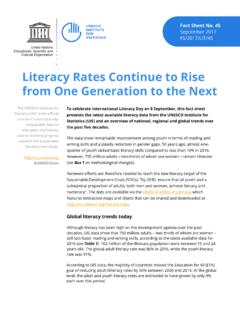Transcription of Monitoring Performance of Electric Utilities - ESMAP
1 Monitoring Performance of Electric Utilities : Indicators and Benchmarking in Sub- saharan africa Monitoring Performance of Electric Utilities Indicators and Benchmarking in Sub- saharan africa Prasad Tallapragada Maria Shkaratan Ada Karina Izaguirre Jaakko Helleranta Saifur Rahman Sten Bergman 2009. Monitoring Performance of Electric Utilities : Indicators and Benchmarking in Sub- saharan africa Prasad Tallapragada Maria Shkaratan Ada Karina Izaguirre Jaakko Helleranta Saifur Rahman Sten Bergman World Bank 2009.
2 Table of Contents I. Introduction 4. II. Defining Key Performance Indices (KPIs) 6. III. Making Sense of Performance Monitoring Indicators 10. IV. Benchmarking Main Performance Indicators 18. Capacity Factor 18. Load Factor 20. Operating Ratio 23. Electric Power Consumption per Capita 25. Household Access to Electricity 30. Quality of Service, Customer Perspective: Outages and Delay with Connection 35. Residential Tariffs 38. Accounts Receivable 41. Cost Recovery Ratio 43. Operating Expenses Covered by Revenues 45.
3 Annex I. Sources of Data 47. Annex II. Indicators of Power Utility Performance in Literature 47. Annex III. Glossary of Indicators and Terms 60. Annex IV. Country Data Tables 75. Annex V. Country Data Graphs 180. Literature 256. 1. PREFACE. This publication is an outcome of the initiative Electric Utility - Capacity Assistance Project for africa (EUCAP), which was developed in the africa Energy Group of the World Bank and financed by the Energy Sector Management Assistance Program ( ESMAP ). The initiative was prepared as a component of the Regional strategy plan to expand capacity in key African institutions and sectors.
4 The core of the initiative is creation of a knowledge-based information-sharing network of African Electric Utilities to pursue the goal of improved utility efficiency. Knowledge-based cooperation among countries is receiving more and more emphasis in regional strategy and approaches to development in africa . As the africa Region's Vice President Oby Ezekwesili emphasized in her recent speech Focus on Innovation, Results, and Knowledge Agenda . (October 14, 2009), a stronger focus on results and the knowledge agenda have become crucially important as the global crisis has led to stronger demand for development impact from the limited resources available.
5 Focus on knowledge-based cooperation was re-emphasized by Colin Bruce (Director of Strategy and Operations, africa Region) who stressed a tremendous appetite to learn from best practices adopted in other countries . The World Bank lending to infrastructure in africa , a large part of which benefits the power sector, has been substantially increasing in the recent past. Talking to the press in 2005, Michel Wormser (Director of Strategy and Operations, africa Region), said: In 2000 we were lending about US$600 million to the African continent for infrastructure and this year we are going to lend US$ billion.
6 We are foreseeing a further 30%. increase, so by the end of the next couple of years, we will probably be at US$ billion to US$ billion a year, he said. This forecast was precise - the World Bank africa infrastructure lending reached $ billion in 2007. In 2009, the World Bank financing for infrastructure-related programs and projects in africa reached US$ billion. Almost 40% of it is power sector lending. Considering this high level of the World Bank's investment in the power sector, it is crucial to assure that the African power Utilities have relevant capacity to use these resources efficiently and to their maximum benefit.
7 The outcomes of the work under the umbrella of this initiative include creation of a comprehensive electricity sector database africa Support Kiosk for Electric Utilities (ASK) and this publication. The initiative is planned to continue, with transferring the data and the data collection methodology to African partner institutions and with a set of activities aimed at building capacity of knowledge-sharing among African Utilities . 2. ACKNOWLEDGEMENT. The authors are very grateful to Iyer (Sector Manager, AFTEG) and Tjaarda P.
8 Storm Van Leeuwen (Adviser, AFTEG) for their review, valuable guidance, advice and support throughout the preparation of the publication. Invaluable advice and general guidance of Inger Andersen (Director, AFTSN), John H. Stein (acting Director, AFTSN). and Jose Luis Irigoyen (Sector Manager, AFTSN) are highly appreciated. The authors would like to express special gratitude for the advice and support received from Amarquaye Armar (Program Manager, ESMAP ). Cooperation with the AICD team was very important for the success of their work.
9 The team expresses gratitude to Vivien Foster and Cecilia Briceno-Garmendia (AICD Task Team Leaders), Sudeshna Ghosh Banerjee, Fatimata Ouedraogo, Daniel Camos and Maria Shkaratan (AICD Energy sector team) for their valuable comments, many brain-storming meetings, cross-team support and day-to-day cooperation with the authors in relation to the database design. The authors are grateful to the AICD team for allowing the use of the AICD data in this publication. This publication was prepared as part of the Electric Utility Capacity Assistance Program (EUCAP) for africa .
10 The authors would like to thank Arun P. Sanghvi (AFTEG), and Abdolreza B. Rezaian (AFTEG), Marjorie K. Araya ( ESMAP , AFTEG) and Marie Lolo Sow team members of the Program for their valuable involvement, ideas and support. The publication was made possible by close cooperation with the World Bank Institute team Adarsh A. Desai, Arseny Malov, Kirill Puklyakov, Oxana Minchenko, Jeeyeon Seo, Steffen Janus who designed the africa Support Kiosk for Electric Utilities (ASK). website. The team is thankful for their expertise and high quality outcomes.






